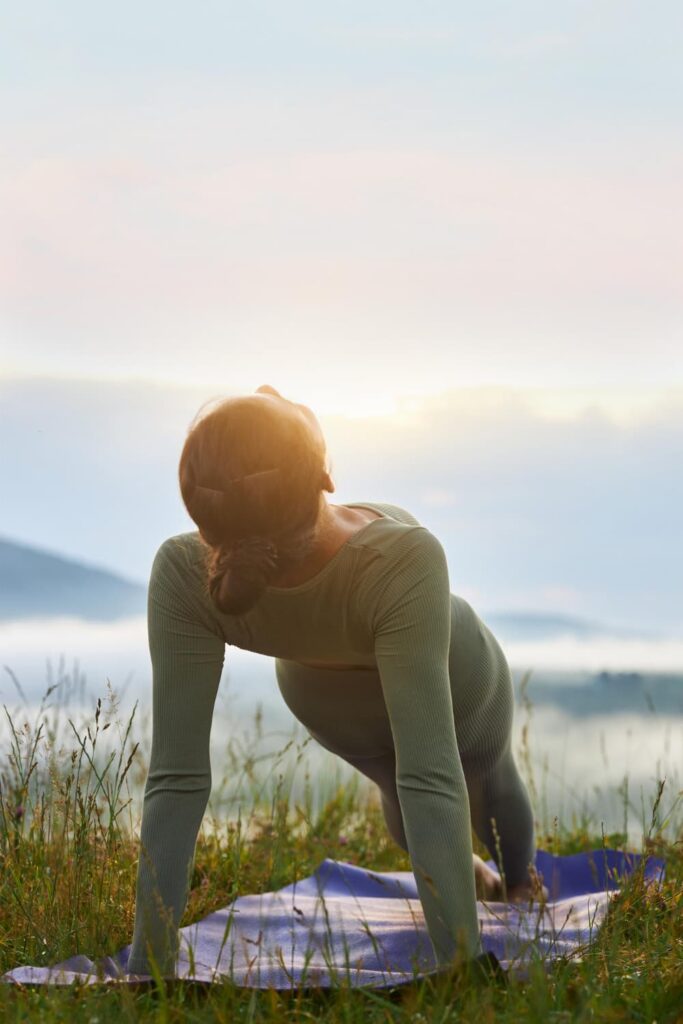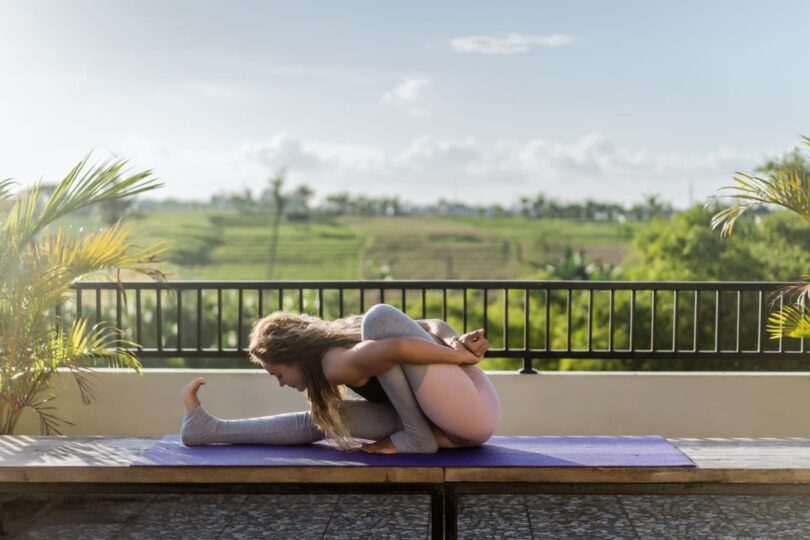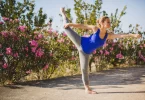Table of Contents
Introduction
Starting your day with a morning yoga routine can make all the difference. It awakens your body, clears your mind, and sets a positive tone for the day ahead. This article will guide you through different yoga routines suitable for all levels, from beginners to advanced practitioners. We’ll discuss the benefits, preparation tips, and specific poses, ensuring you have everything you need to kick-start your day with yoga.
Introduction and Benefits
Introduction to Morning Yoga Routine
Yoga in the morning is like a natural cup of coffee. It wakes you up, stretches your body, and gets your blood flowing. Whether you’re a seasoned yogi or a newbie, starting your day with a yoga routine can bring numerous benefits. So, grab your mat and let’s dive into why morning yoga should be part of your daily ritual.
Benefits of Morning Yoga
Mental Health Benefits Practicing yoga in the morning can significantly improve your mental health. It reduces stress, boosts your mood, and enhances your focus. Imagine starting your day with a clear, calm mind. Morning yoga can help you achieve that by lowering cortisol levels and increasing serotonin production. Yoga for the morning can transform your mental state, making you more resilient and positive.
Physical Health Benefits Yoga isn’t just about flexibility; it’s also great for your physical health. Morning stretches help in improving your posture, increasing your flexibility, and building strength. Moreover, it kick-starts your metabolism and keeps you energized throughout the day. Regular morning yoga routines can help alleviate chronic pains and stiffness, making your body feel young and agile.
Importance of Consistency Consistency is key when it comes to yoga. Practicing yoga every morning builds discipline and sets a routine that your body and mind start to crave. Even a short 10-minute session can make a huge difference if done regularly. Consistency helps in mastering poses and reaping the long-term benefits of yoga. So, make it a habit to roll out your mat every morning, no excuses!
Preparing for Morning Yoga
Setting Up Your Space
Creating the right environment for your morning yoga routine is crucial. You want a space that feels calm and inviting. Choose a quiet spot in your home where you won’t be interrupted. It could be a corner of your bedroom, a space in your living room, or even your backyard if the weather permits.
- Choosing a Quiet Place Find a place away from the hustle and bustle of daily life. This helps you focus and get the most out of your yoga session. A serene environment makes a big difference.
- Necessary Equipment You don’t need much for yoga, but a few items can enhance your practice. A good quality yoga mat is essential. It provides cushioning for your joints and a non-slip surface for stability. Blocks and straps can also be helpful, especially for beginners, as they aid in maintaining proper alignment and reaching deeper into poses.
- Tips for Maintaining a Distraction-Free Environment Turn off your phone or put it on silent. If you have pets or children, try to schedule your yoga time when they’re least likely to need your attention. You might also enjoy playing soft, instrumental music to create a tranquil atmosphere.
What to Wear
Your choice of clothing can significantly impact your comfort and performance during your morning yoga routine. Opt for attire that’s both comfortable and functional.
- Comfortable Clothing Recommendations: Wear clothes that allow you to move freely. Leggings or yoga pants paired with a breathable, fitted top work well. Avoid anything too loose that might get in the way during poses.
- Importance of Non-Restrictive Attire Non-restrictive clothing ensures you can stretch and bend without any limitations. It’s important that your clothes don’t constrict your movement, allowing you to perform poses correctly and comfortably.
Beginner Morning Yoga Routine
Starting your day with a gentle yoga routine can set a positive tone. This beginner-friendly sequence is perfect for waking up your body and mind.
Warm-Up Exercises
Neck Stretches Begin by sitting comfortably on your mat. Slowly tilt your head towards your right shoulder, stretching the left side of your neck. Hold for a few breaths, then switch sides. This simple stretch helps release any tension in your neck and shoulders.
Shoulder Rolls Next, sit in a cross-legged position and place your hands on your knees. Inhale deeply and lift your shoulders up towards your ears. Exhale as you roll them back and down. Repeat this a few times to loosen up your shoulders and improve circulation.
Cat-Cow Pose: Get on all fours with your wrists aligned under your shoulders and your knees under your hips. As you inhale, drop your belly towards the mat, lift your head, and arch your back (Cow Pose). On the exhale, round your back, tuck your chin to your chest, and draw your belly button towards your spine (Cat Pose). This dynamic movement warms up your spine and prepares it for the poses ahead.
Basic Poses
Mountain Pose (Tadasana): Stand at the front of your mat with your feet hip-width apart. Ground down through your feet and engage your thighs. Lift your chest and roll your shoulders back and down. Take a few deep breaths here, feeling the stability and grounding of this pose.
Downward Dog (Adho Mukha Svanasana) From Mountain Pose, bend forward and place your hands on the mat. Step back to form an inverted V-shape. Spread your fingers wide and press firmly into the mat. Keep your knees slightly bent if your hamstrings are tight. Downward Dog stretches your entire body, particularly your shoulders, hamstrings, and calves.
Child’s Pose (Balasana) From Downward Dog, lower your knees to the mat and sit back on your heels. Extend your arms forward and rest your forehead on the mat. This resting pose calms the mind and gently stretches the hips, thighs, and ankles.
Cool-Down and Relaxation
Forward Fold (Uttanasana): Stand up and fold forward from your hips, letting your head hang heavy. Bend your knees slightly to ease any tension in your lower back. This pose helps to release the spine and stretch the hamstrings.
Corpse Pose (Savasana): Lie down on your back with your legs extended and arms by your sides, palms facing up. Close your eyes and take deep, calming breaths. Savasana allows your body to fully relax and absorb the benefits of your practice.
Deep Breathing Exercises: Sit comfortably and place one hand on your belly. Inhale deeply through your nose, allowing your belly to rise. Exhale slowly through your mouth, feeling your belly fall. Repeat this for a few minutes to center your mind and body.
With this beginner morning yoga routine, you’ll start your day feeling refreshed and ready to tackle anything that comes your way.
Related Article: Beginner Yoga Poses For Men: Simple Steps to Start Today

Intermediate Morning Yoga Routine
Ready to take your morning yoga up a notch? This intermediate routine offers a bit more challenge, helping you build strength and flexibility.
Warm-Up Exercises
Sun Salutations (Surya Namaskar) Start at the front of your mat in Mountain Pose. Inhale as you raise your arms overhead, and exhale as you fold forward into a Forward Bend. Inhale to a Halfway Lift, then exhale to step back into Plank Pose. Lower down to Chaturanga, inhale into Upward Dog, and exhale back to Downward Dog. Repeat this flow a few times to warm up your entire body.
Standing Forward Bend (Uttanasana) From Downward Dog, walk your feet towards your hands. Inhale to a Halfway Lift, then exhale to fold deeply, releasing your neck and shoulders. This pose stretches your hamstrings and back, preparing you for more intense poses.
Intermediate Poses
Warrior I (Virabhadrasana I): Step your right foot back into a lunge, ensuring your left knee is directly over your ankle. Pivot your right heel down and align your hips forward. Inhale as you raise your arms overhead, gazing up. Hold for a few breaths, feeling the stretch in your hips and the strength in your legs.
Triangle Pose (Trikonasana) From Warrior I, straighten your front leg and reach your left hand forward, then lower it to your shin, ankle, or the mat. Extend your right arm up towards the sky, opening your chest. Look up at your right hand, feeling the stretch along your side body and the engagement in your legs.
Tree Pose (Vrksasana): Return to standing and shift your weight onto your left foot. Place the sole of your right foot on your inner left thigh or calf (avoid the knee). Bring your hands to your heart center, or raise them overhead for a greater challenge. This balancing pose strengthens your legs and core while improving focus.
Cool-Down and Relaxation
Pigeon Pose (Eka Pada Rajakapotasana) From Downward Dog, bring your right knee forward to your right wrist, lowering your right shin to the mat. Extend your left leg back and lower your hips. Hold this pose to stretch your hips deeply. Switch sides after a few breaths.
Seated Forward Bend (Paschimottanasana): Sit with your legs extended in front of you. Inhale to lengthen your spine, and exhale as you fold forward, reaching for your feet or shins. This pose stretches your hamstrings and back, promoting relaxation.
Deep Breathing and Mindfulness: Sit comfortably with your eyes closed. Practice deep breathing, focusing on each inhale and exhale. Let go of any tension and allow yourself to be present in the moment.
Advanced Morning Yoga Routine
For seasoned yogis, this advanced morning yoga routine offers a series of challenging poses that build strength, flexibility and focus.
Warm-Up Exercises
Dynamic Stretches Begin with some dynamic stretches to get your blood flowing. Swing your arms, twist your torso, and gently bounce on your toes. These movements will loosen up your muscles and joints, preparing you for more intense poses.
Advanced Sun Salutations Start with a standard Sun Salutation but add more advanced elements. After Upward Dog, lift one leg into the air for a Three-Legged Downward Dog, then bring your knee to your nose before stepping forward into a lunge. Incorporate jump-backs and jump-throughs to increase the intensity and engage your core.
Advanced Poses
Crow Pose (Bakasana): From a squat position, place your hands on the mat shoulder-width apart. Lift your hips and bring your knees to your upper arms. Shift your weight forward, balancing on your hands. Crow Pose builds arm strength and improves balance.
Wheel Pose (Urdhva Dhanurasana): Lie on your back with your knees bent and feet flat on the floor. Place your hands beside your head with your fingers pointing towards your shoulders. Press into your hands and feet, lifting your body into a backbend. This pose opens the chest and strengthens the entire body.
Headstand (Sirsasana). Kneel on the mat and interlace your fingers, placing your forearms on the ground. Rest the crown of your head between your hands. Lift your hips and walk your feet towards your head. Slowly lift your legs, straightening them into a vertical position. Headstand requires core strength and focus, offering numerous benefits for balance and concentration.
Cool-Down and Relaxation
Fish Pose (Matsyasana): Lie on your back with your legs extended and your arms by your sides. Slide your hands under your hips, palms down. Press into your forearms and lift your chest, arching your back. Rest the crown of your head on the mat, opening your throat and chest.
Supine Spinal Twist (Supta Matsyendrasana) Lie on your back and hug your knees to your chest. Extend your arms out to the sides and drop your knees to the right, turning your head to the left. Hold for a few breaths, and then switch sides. This twist releases tension in your spine and aids in digestion.
Meditation Practices End your advanced routine with a few minutes of meditation. Sit comfortably, close your eyes, and focus on your breath. Allow your mind to settle and embrace the calmness. Meditation helps to center your thoughts and brings a sense of peace and clarity to your day.
This advanced morning yoga routine challenges your body and mind, pushing your limits and helping you achieve new heights in your practice.
FAQs About Morning Yoga Routine
What is the Best Morning Yoga?
The best morning yoga routine is one that suits your fitness level and personal preferences. For beginners, a gentle sequence that includes basic poses like Mountain Pose, Downward Dog, and Child’s Pose is ideal. Intermediate practitioners might enjoy a routine with Sun Salutations, Warrior Poses, and Triangle Pose. Advanced yogis can challenge themselves with poses like Crow, Wheel, and Headstand. The key is to choose poses that wake up your body and mind, setting a positive tone for the day.
Is it Good to Do Yoga in the Morning?
Absolutely! Doing yoga in the morning has numerous benefits. It helps wake up your body, improves circulation, and boosts energy levels. Morning yoga also sets a calm and focused tone for the day, reducing stress and enhancing mental clarity. Practicing yoga in the morning ensures you get your exercise done early, which can be particularly beneficial if you have a busy schedule.
Is 20 Minutes of Yoga a Day Enough?
Yes, 20 minutes of yoga a day is enough to reap significant benefits. Even a short daily practice can improve flexibility, build strength, and reduce stress. Consistency is more important than duration, so a daily 20-minute routine can be very effective. You can mix and match poses to keep your routine interesting and address different areas of the body each day.
How to Start Yoga in the Morning?
Starting yoga in the morning is simple. Here’s a step-by-step guide:
Set a Regular Time: Choose a time that works best for you and stick to it. Consistency helps in forming a habit.
Create a Calm Space: Find a quiet spot where you can practice without interruptions. Set up your mat and keep any props handy.
Wear Comfortable Clothing: Dress in clothes that allow you to move freely.
Begin with Gentle Stretches: Start with a few gentle stretches to wake up your body. Neck stretches and shoulder rolls are good options.
Follow a Sequence: Choose a sequence of poses that you enjoy. You can follow a video, use a yoga app, or create your own routine.
End with Relaxation: Always finish with a few minutes of relaxation or meditation. This helps to calm your mind and set a positive tone for the day.
Conclusion
Incorporating a morning yoga routine into your daily life can make a world of difference. From waking up your body and mind to reducing stress and improving flexibility, the benefits are immense. Whether you’re a beginner starting with basic poses or an advanced practitioner challenging yourself with complex sequences, yoga offers something for everyone.
Consistency is key. Even a short 20-minute session each day can lead to significant improvements in your overall well-being. Setting up a dedicated space, wearing comfortable clothing, and following a structured sequence can help you establish a routine that you’ll look forward to each morning.
Remember, the best yoga routine is the one that suits you. Listen to your body, progress at your own pace, and most importantly, enjoy the practice. Starting your day with yoga not only prepares you physically but also mentally, setting a positive and focused tone for whatever lies ahead.
Related Article: Yoga Wheel: Benefits, Poses, and Workouts Guide







